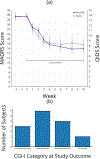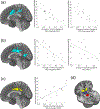Effects of the KCNQ channel opener ezogabine on functional connectivity of the ventral striatum and clinical symptoms in patients with major depressive disorder
- PMID: 30385872
- PMCID: PMC6494706
- DOI: 10.1038/s41380-018-0283-2
Effects of the KCNQ channel opener ezogabine on functional connectivity of the ventral striatum and clinical symptoms in patients with major depressive disorder
Abstract
Major depressive disorder (MDD) is a leading cause of disability worldwide, yet current treatment strategies remain limited in their mechanistic diversity. Recent evidence has highlighted a promising novel pharmaceutical target-the KCNQ-type potassium channel-for the treatment of depressive disorders, which may exert a therapeutic effect via functional changes within the brain reward system, including the ventral striatum. The current study assessed the effects of the KCNQ channel opener ezogabine (also known as retigabine) on reward circuitry and clinical symptoms in patients with MDD. Eighteen medication-free individuals with MDD currently in a major depressive episode were enrolled in an open-label study and received ezogabine up to 900 mg/day orally over the course of 10 weeks. Resting-state functional magnetic resonance imaging data were collected at baseline and posttreatment to examine brain reward circuitry. Reward learning was measured using a computerized probabilistic reward task. After treatment with ezogabine, subjects exhibited a significant reduction of depressive symptoms (Montgomery-Asberg Depression Rating Scale score change: -13.7 ± 9.7, p < 0.001, d = 2.08) and anhedonic symptoms (Snaith-Hamilton Pleasure Scale score change: -6.1 ± 5.3, p < 0.001, d = 1.00), which remained significant even after controlling for overall depression severity. Improvement in depression was associated with decreased functional connectivity between the ventral caudate and clusters within the mid-cingulate cortex and posterior cingulate cortex (n = 14, voxel-wise p < 0.005). In addition, a subgroup of patients tested with a probabilistic reward task (n = 9) showed increased reward learning following treatment. These findings highlight the KCNQ-type potassium channel as a promising target for future drug discovery efforts in mood disorders.
Conflict of interest statement
CONFLICT OF INTEREST
In the past 5 years, Dr. Murrough has provided consultation services to Sage Therapeutics, Novartis, Allergan, Fortress Biotech, Janssen Research and Development, Genentech, MedAvante-ProPhase, and Global Medical Education (GME) and has received research support from Avanir Pharmaceuticals, Inc. Dr. Murrough is named on a patent pending for neuropeptide Y as a treatment for mood and anxiety disorders. The Icahn School of Medicine (employer of Dr. Murrough) is named on a patent and has entered into a licensing agreement and will receive payments related to the use of ketamine if it is approved for the treatment of depression. Dr. Murrough is not named on this patent and will not receive any payments. Dr. Collins has received consulting fees from MedAvante-ProPhase for services unrelated to this study. In the past three years, Dr. Pizzagalli received consulting fees from Akili Interactive Labs, BlackThorn Therapeutics, Boehreinger Ingelheim, Pfizer, and Posit Science for activities unrelated to the present study. In the past three years, Dr. Iosifescu has provided consultations to Alkermes, Axsome, MyndAnalytics (CNS Response), Jazz, Lundbeck, Otsuka, Sunovion, and has received research support (through his academic institutions) from Alkermes, Astra Zeneca, Brainsway, LiteCure, Neosync, Roche, and Shire. All other authors declare no conflicts of interest.
Figures



References
-
- Rush AJ, Trivedi MH, Wisniewski SR, Nierenberg AA, Stewart JW, Warden D, et al. Acute and longer-term outcomes in depressed outpatients requiring one or several treatment steps: A STAR*D report. Am J Psychiatry. 2006;163(11):1905–17. - PubMed
-
- Tollefson GD, Holman S. How long to onset of antidepressant action: a meta-analysis of patients treated with fluoxetine or placebo. Int Clin Psychopharmacol. 1994;9:245–50. - PubMed
-
- Berton O, Nestler EJ. New approaches to antidepressant drug discovery: Beyond monoamines. Nat Rev Neurosci. 2006;7(2):137–51. - PubMed
Publication types
MeSH terms
Substances
Grants and funding
LinkOut - more resources
Full Text Sources
Other Literature Sources

